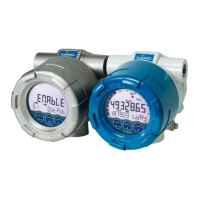E018-P
FW_E018-P_M_v0302-02_EN Page 25
Formula
Pulse per US gallon x cubic foot (in gallons) = K-factor
65.231 x 7.48052 = 487.9618
For this example, enter 487.9618 as the K-factor for total or flowrate.
5 FLOWMETER
5.1 SIGNAL
Selects the type of flowmeter pickup / signal. The unit can process
several types of input signal. The settings with LP are used to apply a
built-in low-pass filter. Also see Section 6.4.10: Terminals S1-S3:
Flowmeter input[»45] for more information.
The selections “Active pulse input” offer a pulse detection level of about
50% of the selected active pulse voltage.
FLOWMETER SELECTION CHARACTERISTICS
TYPE OF SIGNAL EXPLANATION RESISTANCE FREQ / mVpp REMARKS
NPN NPN input 100kΩ pull-up max.6kHz Open collector
NPN - LP
NPN input
with low pass filter
100kΩ pull-up max.2.2kHz
Open collector
Less sensitive
REED Reed-switch input 1MΩ pull-up max.1.2kHz
REED - LP
Reed-switch input
with low pass filter
1MΩ pull-up max.120Hz Less sensitive
PNP PNP input 51kΩ pull-down max.6kHz
PNP - LP
PNP input
with low pass filter
51kΩ pull-down max.700Hz Less sensitive
NAMUR NAMUR input 820Ω pull-down max.4kHz
External sensor
power required
COIL HI
Coil input
high sensitivity
-
min.20mVpp
Sensitive for
interference!
Type ZF min.10mVpp
Type ZG min.5mVpp
COIL LO
Coil input
low sensitivity
- min.90mVpp Normal sensitivity
8-2 DC
Active pulse input
detection level
3.9Vdc
3k9 Ω pull-down max.10kHz
External power
required
24 DC
Active pulse input
detection level
11Vdc
3k Ω pull-down max.10kHz
External power
required
5.5.6 MENU 6: LINEARIZATION
Linearization principle
In normal situations, the calculation of flow is based on flowmeters that follow an ‘ideal line’ and give
a fixed number of pulses over the entire frequency range to represent a certain amount. The
calculation uses an average K-factor KF0, which corresponds to the factors at
1.3: TOTAL > K-
FACTOR and 2.4: FLOWRATE > K-FACTOR.
Since many flowmeters do not follow this ‘ideal line’, the linearization function can be used to reflect
the actual flow curve better. This allows for more accurate flowrate and totalization values, as well as
improved analog and pulse output values over the frequency range of the flowmeter. The
linearization function uses linearization points to calculate new K-factors based on the measured
flowmeter frequency. As shown in the chart below, each point consists of a frequency and a Meter
Factor (MFx, indicating the deviation of the K-factor KFx from the average K-factor KF0).

